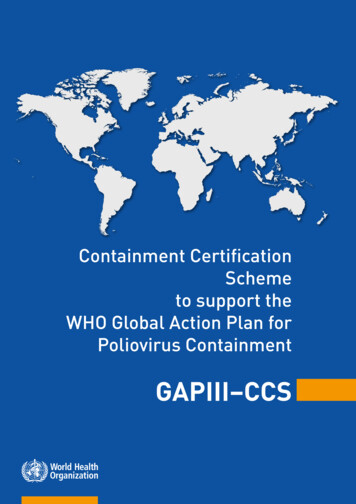
Transcription
Containment CertificationSchemeto support theWHO Global Action Plan forPoliovirus ContainmentGAPIII CCS
Containment CertificationSchemeto support theWHO Global Action Plan forPoliovirus ContainmentGAPIII CCSContainment CertificationScheme (CCS) to supportthe certification of facilitiesagainst the WHOGlobal Action Plan tominimize poliovirusfacility-associated riskafter type-specificeradication of wildpolioviruses and sequentialcessation of oral poliovaccine use (GAPIII,Annex 2 and Annex 3)
Containment certification scheme to support the WHO global action plan for poliovirus containment.ISBN 978-92-4-151147-6 World Health Organization 2017Some rights reserved. This work is available under the Creative Commons Attribution-NonCommercialShareAlike 3.0 IGO licence (CC BY-NC-SA 3.0 IGO; igo).Under the terms of this licence, you may copy, redistribute and adapt the work for non-commercial purposes,provided the work is appropriately cited, as indicated below. In any use of this work, there should be nosuggestion that WHO endorses any specific organization, products or services. The use of the WHO logo isnot permitted. If you adapt the work, then you must license your work under the same or equivalent CreativeCommons licence. If you create a translation of this work, you should add the following disclaimer along withthe suggested citation: “This translation was not created by the World Health Organization (WHO). WHO is notresponsible for the content or accuracy of this translation. The original English edition shall be the bindingand authentic edition”.Any mediation relating to disputes arising under the licence shall be conducted in accordance with themediation rules of the World Intellectual Property Organization.Suggested citation. Containment certification scheme to support the WHO global action plan for polioviruscontainment. Geneva: World Health Organization; 2017. Licence: CC BY-NC-SA 3.0 IGO.Cataloguing-in-Publication (CIP) data. CIP data are available at http://apps.who.int/iris.Sales, rights and licensing. To purchase WHO publications, see http://apps.who.int/bookorders. To submitrequests for commercial use and queries on rights and licensing, see http://www.who.int/about/licensing.Third-party materials. If you wish to reuse material from this work that is attributed to a third party, such astables, figures or images, it is your responsibility to determine whether permission is needed for that reuseand to obtain permission from the copyright holder. The risk of claims resulting from infringement of anythird-party-owned component in the work rests solely with the user.General disclaimers. The designations employed and the presentation of the material in this publication donot imply the expression of any opinion whatsoever on the part of WHO concerning the legal status of anycountry, territory, city or area or of its authorities, or concerning the delimitation of its frontiers or boundaries.Dotted and dashed lines on maps represent approximate border lines for which there may not yet be fullagreement.The mention of specific companies or of certain manufacturers’ products does not imply that they areendorsed or recommended by WHO in preference to others of a similar nature that are not mentioned. Errorsand omissions excepted, the names of proprietary products are distinguished by initial capital letters.All reasonable precautions have been taken by WHO to verify the information contained in this publication.However, the published material is being distributed without warranty of any kind, either expressed orimplied. The responsibility for the interpretation and use of the material lies with the reader. In no event shallWHO be liable for damages arising from its use.Design and layout: Paprika (Annecy, France)
CONTENTSAcknowledgements.VIAbbreviations and acronyms.VIIDefinitions.VIII1. INTRODUCTION.11.1 Purpose.11.2 Maintenance.21.3 Background.21.4 CCS objectives.21.5 Nature and type of facilities addressed by the CCS.31.6 Roles and responsibilities.31.7 Delegation of activities.42. CONTAINMENT CERTIFICATION PROCESS.52.1 Certificate of participation.52.2 Interim certificate of containment.62.3 Certificate of containment.82.4 GCC-endorsed certificates.92.5 Modification, suspension, withdrawal, complaints and appeals.93. THE AUDIT TEAM.103.1 Qualification of auditors and technical experts for GAPIII certification.103.2 Audit team roles and functions.103.3 Auditor competencies.113.4 Education and work experience .113.5 Auditing experience and CCS training.133.6 Personal attributes.143.7 Auditor qualification and requalification.14 3.8 Trainer qualifications to provide GAPIII Training for Auditors.153.9 Calibration of CCS delivery.153.10 Technical experts.154 CONDUCTING CCS AUDITS.164.1 Audit team selection and preparation.164.2 Audit planning.164.3 Information requirements.174.4 Audit announcement.174.5 On-site audit activities.174.6 Generating findings.194.7 Reporting and follow-up.214.8 Containment certification review and approval.225. COSTS AND CHARGES.236. CCS FEEDBACK AND REVIEW.247. SAMPLE TEMPLATES.25REFERENCES.26V
ACKNOWLEDGEMENTSThe development of this first edition of the GAPIII Containment Certification Scheme (CCS) to support theWHO Global Action Plan to minimize poliovirus facility-associated risk after type-specific eradication of wildpolioviruses and sequential cessation of oral polio vaccine use (GAPIII) (1) has been made possible through thecontributions of the following, whose expertise is gratefully acknowledged:Paul J. Huntly, Riskren PTE Ltd, SingaporeJane Toh, Riskren PTE Ltd, SingaporeNicoletta Previsani, WHOThe contributions of the following reviewers are also recognized with appreciation:Walter Dowdle, Jackie Fournier-Caruana, Robert Freeman, Mary Louise Graham, Paul Griffiths, Gary Lum,Phil Minor, Steve Oberste, Mark Pallansch, Richard Pebody, Hiroyuki Shimizu, Graham Tallis, Bruce Thorleyand Jan-Willem van den Brink.The GAPIII Containment Certification Scheme (CCS) was endorsed by the WHO Strategic Advisory Group ofExperts on Immunization in October 2016 (2).VI
ABBREVIATIONS AND ACRONYMSCCCertificate of containmentCCSContainment Certification SchemeCENEuropean Committee for StandardizationCPCertificate of participationCWACEN Workshop AgreementGAPIIIGlobal Action Plan IIIGCCGlobal Commission for the Certification of the Eradication of PoliomyelitisGPEIGlobal Polio Eradication InitiativeICCInterim certificate of containmentICC-NCInterim certificate of containment-specific nonconformityIECInternational Electrotechnical CommissionISOInternational Organization for StandardizationNACNational authority for containmentNCNonconformityNC1Category 1 (major) nonconformityNC2Category 2 (minor) nonconformityOHSASOccupational Health and Safety Assessment SeriesOPVOral polio vaccinePEFPoliovirus-essential facilityVDPVVaccine-derived poliovirusWHAWorld Health AssemblyWHOWorld Health OrganizationWPVWild poliovirusVII
DEFINITIONSAudit: The systematic, independent1 anddocumented process for obtaining audit evidenceand evaluating it objectively to determine the extentto which audit criteria are fulfilled. In the contextof the Containment Certification Scheme, the term“audit” may be applied to a gap assessment and/or interim certificate of containment/certificate ofcontainment assessments.Biorisk: Risk relating to biosafety and biosecuritywhere the principal hazard is a biological agent (inthe case of this document, poliovirus).Biorisk management system: The organizationalstructure, planning activities, responsibilities,practices, procedures, processes and resourcesfor developing, implementing, achieving, reviewingand maintaining an organization’s bioriskmanagement policy.Biosafety: The containment principles,technologies and practices that are implementedto prevent unintentional exposure to pathogens andtoxins, or their accidental release.Biosecurity: The protection, control andaccountability for biological agents and toxinswithin biological facilities to prevent theirunauthorized access, loss, theft, misuse anddiversion, or their intentional unauthorized release.Certificate of containment (CC): A certificatethat can only be awarded to poliovirus-essentialfacilities that hold a valid certificate of participation/interim certificate of containment. A CC indicatesthat the poliovirus-essential facility has achievedfull compliance with Annex 2 or 3 of GAPIII, asindependently verified by the national authority forcontainment of the hosting country, in consultationwith the Global Commission for the Certificationof the Eradication of Poliomyelitis (GCC). A GCCendorsed CC bears the signature of the GCC and aunique CC number.Certificate of containment, interim (ICC):A certificate that can only be awarded to facilitiesthat hold a valid certificate of participation. AnICC indicates that the poliovirus-essential facilitydoes not meet all the requirements of GAPIII buthas identified the outstanding gaps in complianceand has adequate interim measures in place asverified by the national authority for containment.Action must be taken to address the need for fullconformity to GAPIII, or to prepare for the cessationof work to defined timescales. An ICC is awardedto a poliovirus-essential facility by the national Independent from the organization being audited.1VIIIauthority for containment of its hosting country,in consultation with the GCC. A GCC-endorsedICC bears the signature of the GCC and a uniqueICC number.Certificate of participation (CP): A certificate thatcan only be awarded to facilities in countries thathave demonstrated compliance with the requiredsecondary and tertiary safeguards described inGAPIII. A CP indicates that the national authorityfor containment, in consultation with the GCC,has recognized a facility as a suitable candidateto become a poliovirus-essential facility. A CPformalizes the eligibility of the facility to engagein the GAPIII CCS process and its commitmentto achieve an interim certificate of containment/certificate of containment. A GCC-endorsed CPbears the signature of the GCC and a uniquecertificate of containment number.Certification: The systematic, documented processto ensure systems perform in accordance withavailable certification standards or applicablevalidation guidance.Containment: A system for confiningmicroorganisms, organisms or other entities withina defined space.Facility: Any site (e.g. laboratory, repository orvaccine production unit) owned or operated byany level of government, academic institution,corporation, company, partnership, society,association, firm, sole proprietorship or otherlegal entity.Facility, poliovirus-essential (PEF): A facilitydesignated by the ministry of health or anotherdesignated national body or authority as servingcritical national or international functions thatinvolve the handling and storage of neededpoliovirus materials post-eradication underconditions set out in Annex 2 or 3 of GAPIII.According to GAPIII, facilities are required to holda valid certificate to handle and store poliovirusesbeyond Phase I.Gap assessment: A technique used to determinethe steps needed to move from an existing stateto a desired future state. A gap assessmentperformed by members of the audit team,for example, allows a facility to have a betterunderstanding of its existing situation and of thesteps it should undertake to achieve full conformityto GAPIII requirements.Global Certification Commission (GCC): Theterm commonly used to refer to the GlobalCommission for the Certification of the Eradication
of Poliomyelitis, which has the responsibility todefine the parameters and processes by which polioeradication is certified.Guidelines: Principles or criteria guiding ordirecting action.Initial visit: A preliminary site visit of a facilityby members of the audit team to evaluate thereadiness of an organization before a full audit. Italso provides an opportunity for the audit team todevelop the Audit Plan and identify focus areas forthe initial certification audit.Inspection: A conformity evaluation by observationand judgement, accompanied as appropriate bymeasuring, testing or gauging.Interim certificate of containment (ICC):see Certificate of containment, interim.Interim certificate of containment-specificnonconformity (ICC-NC): Nonconformity thatcannot be closed due to the need for majorstructural work or other similar reasons, thuspreventing the issuance of a full certificate ofcontainment. All outstanding ICC-NCs must beclosed prior to the issuance of a certificate ofcontainment. By definition, all ICC-NCs will beNC1s since they represent an absence of one ormore required system elements.National authority for containment (NAC):The national authority responsible for GAPIIIcontainment certification. NACs are nominatedby the ministry of health or other designatednational authorities.Nonconformity (NC): Non-fulfilment of arequirement; the occurrence of a condition thatdoes not conform to the specifications of theprescribed standard.Organization: The legal entity responsible for themanagement of the facility, such as a university,private company or government agency.Poliovirus-essential facility (PEF): see Facility,poliovirus-essential.Safeguards, primary: Containment precautionsand stipulations designed to minimize the facilityassociated poliovirus risk of exposing and/or infecting populations. Primary containmentsafeguards reduce the likelihood of accidental ormalicious release of poliovirus from a poliovirusessential facility and subsequent transmission tothe population. Poliovirus-essential facilities areresponsible for the identification, implementationand maintenance of effective primary safeguards.Safeguards, secondary: The population immunityprofile consistent with minimizing the consequenceof a poliovirus release from a poliovirus-essentialfacility, consisting of a national routine childhoodimmunization policy and national populationcoverage in line with GAPIII. The country hostingthe poliovirus-essential facility is responsible forthe implementation of the secondary safeguards,a prerequisite for the containment certificationof facilities retaining polioviruses as of Phase IIof GAPIII.Safeguards, tertiary: The sanitation andhygiene conditions (good personal, domestic andenvironmental hygiene standards and closedsewage systems with secondary or greatereffluent treatment) that minimize the risk of reestablishing the circulation of highly transmissiblewild poliovirus in the event of reintroduction. Thecountry hosting the poliovirus-essential facility isresponsible for the implementation of the tertiarysafeguards, a prerequisite for the containmentcertification of facilities retaining wild poliovirus inPhase III.Standard: A document that provides requirements,specifications, guidelines or characteristics thatcan be used consistently to ensure that materials,products, processes and services are fit fortheir purpose.Validation: Confirmation, through the provisionof objective evidence, that the requirementsfor a specific intended use or application havebeen fulfilled.Verification: Confirmation, through the provisionof objective evidence, that specified requirementshave been fulfilled.IX
Introduction1.IntroductionThis document, GAPIII Containment CertificationScheme, defines the recommended mechanism forcertification associated with global confirmation ofpoliovirus containment within poliovirus-essentialfacilities (PEFs). The World Health Organization (WHO)Containment Certification Scheme (CCS) describedhere supplements the WHO Global Action Plan tominimize poliovirus facility-associated risk aftertype‑specific eradication of wild polioviruses andsequential cessation of oral polio vaccine use (GAPIII)and poliovirus eradication timelines and requirementsto minimize facility-associated poliovirus risk.GAPIII requires that the primary safeguards offacility containment, secondary safeguards ofpopulation immunity, and tertiary safeguards offacility location and associated environmentalcontrols be set in place to effectively controland minimize the risks of facility-associatedpoliovirus release after eradication. While theprimary safeguards are controlled by the PEFsthemselves, the secondary and tertiary safeguardsare controlled by the facility-hosting countries. As aresult, close coordination between the facilities andhosting countries is key to achieving the objectiveof retaining needed poliovirus materials in a limitednumber of PEFs worldwide.The poliovirus containment certification processdescribed in this CCS document begins with thefacility-hosting country demonstrating that therequired secondary and tertiary safeguards, i.e. therequired levels of population immunity togetherwith facility location and environmental controls,are in place. While the appropriate implementationof secondary and tertiary safeguards is aprerequisite for containment certification againstprimary safeguards, the CCS addresses only theassessment of primary safeguards.This document describes the containmentcertification requirements as applicable toGAPIII Annexes 2 and 3. Annex 2 describes posteradication containment requirements applicableto facilities retaining wild poliovirus (WPV), whichincludes vaccine-derived poliovirus (VDPV) strains.1Annex 3 describes containment requirementsapplicable to facilities retaining oral polio vaccine(OPV)/Sabin viruses. As GAPIII does not requirecertification of the facilities implementingstandards for the safe handling of new samplespotentially containing poliovirus material inpoliovirus-non-essential facilities (GAPIII Annex 6),the laboratories adopting these measures are notcovered by the CCS.Once polio is eradicated, laboratories, repositoriesand polio vaccine production facilities handling orstoring poliovirus materials must minimize the riskof poliovirus reintroduction into the community.1.1 PURPOSEThe aim of the CCS is to ensure a globallyharmonized approach for the certification ofPEFs against the implementation of primarysafeguards of containment. The CCS providesguidance to stakeholders in terms of expectations,mechanisms, roles, responsibilities and timelinesassociated with the certification process. Thesuccessful adoption of this mechanism by countrieshosting PEFs will result in the ability to award acertificate of containment endorsed by the GCC asestablished for this purpose.Failure to observe the requirements set out in thisdocument could lead to challenges in the GCC’sability to report a globally harmonized approach tothe certification of poliovirus containment. Althoughadherence to the CCS is voluntary, all countrieshosting PEFs are strongly encouraged to participateso they effectively contribute to the mechanism thatallows the GCC to assure the global communitythat GAPIII is being implemented adequately andconsistently around the world. While countriesmay elect to adopt alternative mechanisms, thelatter may not meet the CCS’s requirements, andthese alternative schemes will not be assessedon an individual basis for parity with the CCS.Any certificates issued under such arrangementswill not receive GCC endorsement.
1.2 MAINTENANCEWHO is responsible for developing and maintainingthe CCS and publishing this document.1.3 BACKGROUNDGAPIII was developed by WHO to provide amodern, comprehensive, risk-based and practicalframework to ensure organizations that will handleand/or store stocks of poliovirus after typespecific eradication will do so with due regard forbiorisk management. A key GAPIII principle is thatonly those facilities that serve critical functionswould be expected to continue to operate, therebyreducing the number of PEFs worldwide andminimizing the risk of unauthorized release ofpoliovirus post-eradication. Such facilities mayinclude those that manage: i nactivated polio vaccine and Sabin-inactivatedpolio vaccine production; t he production and storage of stockpiles ofmonovalent oral polio vaccines; vaccine quality control; d iagnostic reagent production involvingpoliovirus; poliovirus diagnostic and reference functions; and crucial poliovirus-related research.Annexes 2, 3 and 6 in GAPIII describe a bioriskmanagement system approach based on16 elements derived from CWA15793 – Laboratorybiorisk management (2011) (3). The 16 elementsaddress all areas associated with the design,operation and management of the facilities thatwill be responsible for ensuring that the risk ofaccidental or malicious release of poliovirus aftertype-specific eradication is minimized.This document outlines the CCS, defining key roles,responsibilities and associated mechanisms forstakeholders relating to the scheme. A criticalaspect of maintaining both biorisk managementcontrols and associated confidence in thesecontrols will be the ongoing need to certify thatpoliovirus containment measures are beingeffectively implemented and maintained. Theassessment and approval mechanisms relatingto containment also form a crucial element ofpost‑eradication legacy planning.IntroductionThe ability to demonstrate that a NAC has adoptedan agreed and approved mechanism may helpstakeholders to assess the validity of nationalcertificates. Although the impact of the certificationscheme is not yet fully known, a laboratory facilitythat holds a GCC-endorsed and countersignedcertificate may subsequently be more likely tomaintain international collaborations. Similarly, aGCC-endorsed and countersigned certificate mayfacilitate the placing of polio vaccine manufacturingproducts on the market in certain countries.A fundamental principle of GAPIII and the CCSis that the responsibility for the design andimplementation of adequate and appropriateoversight measures relating to individual PEFs andtheir alignment with local conditions (includingnational regulations) rests with the NACs. Anumber of templates relating to the CCS areavailable via the Global Polio Eradication Initiative(GPEI) website to support the certification scheme’sroll-out and implementation. It should be notedthat such information and guidance are provided forreference only, neither indicating that the examplesprovided are the only tools that may be consideredsuitable, nor that they are necessarily all that isrequired to demonstrate compliance with GAPIIIand/or the measures described in this document.1.4 CCS OBJECTIVESThe objectives of the CCS are to:1. i dentify and define the roles and responsibilitiesof the parties who will develop, implementand monitor the CCS, including the provisionof required oversight, transparency andconsistency of the approach;2. s pecify the mechanisms required for oversightat the international and national levels,ensuring robust, transparent and equitablemeans are applied for containment certificationacross sectors and geographies;3. d escribe the relevant oversight mechanismsto assure that GAPIII controls have beenappropriately identified, implemented andmonitored in accordance with timelines alignedwith the eradication programme; and4. d efine and execute appropriate recording andreporting mechanisms, ensuring confidence inthe CCS and its ability to provide the requiredlevel of assurance to stakeholders and theglobal community.The CCS is similar in nature to that used in otherrisk-based management system certificationschemes (e.g. Occupational Health and SafetyAssessment Series (OHSAS) 18001 (4)) , aiming toprovide an assurance of compliance against criticalaspects of poliovirus containment, while alsoensuring organizations focus on the critical areasthat matter most in driving continual improvement.The structure and nature of GAPIII and theassociated CCS are therefore designed to enablePEFs to demonstrate strict poliovirus-specificcontrol measures, while improving performance2
Introductionthrough the consistent adoption of recognized goodpractice in biorisk management.Although ownership for oversight and containmentcertification of PEFs rests with designated NACsand the GCC, the scheme will be delivered throughengagement with a variety of stakeholders,including ministries of health (and other relevantgovernment entities) and WHO.1.5 NATURE AND TYPE OFFACILITIES ADDRESSED BYTHE CCSThe facility types and activities covered by theCCS are:1. polio vaccine production facilities, includingassociated quality-control laboratories, animalhouses, filling lines, packaging areas, vaccine/seed storage areas and other relevant spaces;2. national control laboratories involved in thecontrol and release of poliomyelitis vaccines;3. facilities that conduct basic and biomedicalresearch and clinical trials with polioviruses,and those that may use polio material forquality control, testing and/or validationpurposes, and those producing diagnostic kitsand/or materials for reference or other formsof testing; and4. facilities housing repositories, culturecollections and other specialized anddedicated forms of storage of polioviruses,including vaccine stockpiles that must be keptfor a number of years, even beyond expiry/withdrawal dates.Depending on the risk, nature and scale ofprocesses and other relevant factors associatedwith each of the above, the audit duration, auditteam profile, competence requirements and otherfactors will be defined and addressed as part of thecontainment certification process.1.6 ROLES ANDRESPONSIBILITIESOversight mechanisms have been set in place toensure poliovirus will be contained within PEFs.The following sections describe thesemechanisms and how they relate to the variousresponsible parties.Poliovirus-essential facilityThe PEF:1. establishes, implements and maintains abiorisk management system aligned with therequirements set out in GAPIII;2. provides relevant parties (NAC, audit teammembers, GCC) with access to all informationand facilities relevant to containmentcertification activities;3. achieves and maintains containmentcertification and operates within the termsof the certificate throughout the certificationcycle; and4. reports to the NAC and other relevant partiesany event, change to processes or other issuethat could jeopardize the status of a certificateunder the CCS.National authority for containment2The NAC:1. ensures and demonstrates that the requiredprimary, secondary and tertiary
1 Independent from the organization being audited. authority for containment of its hosting country, in consultation with the GCC. A GCC-endorsed ICC bears the signature of the GCC and a unique ICC number. Certificate of participation (CP): A certificate that can only be awarded to facilities in countries that


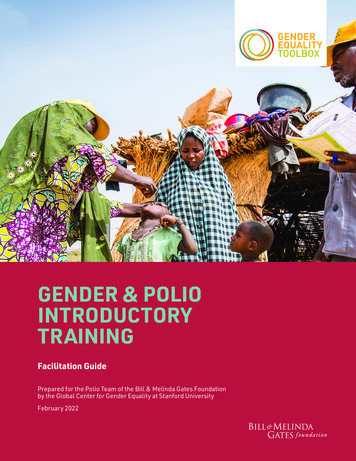

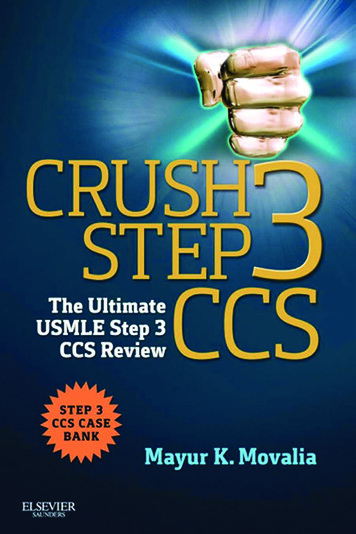
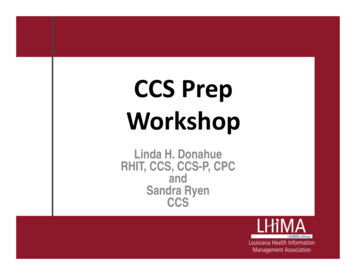

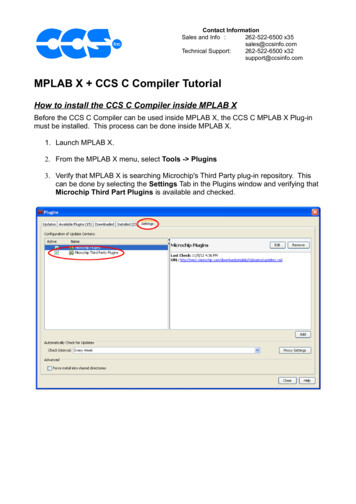


![[Concept Note] Polio Environmental Surveillance Enhancement Following .](/img/60/es-obr-nopv2-revision-20200601.jpg)